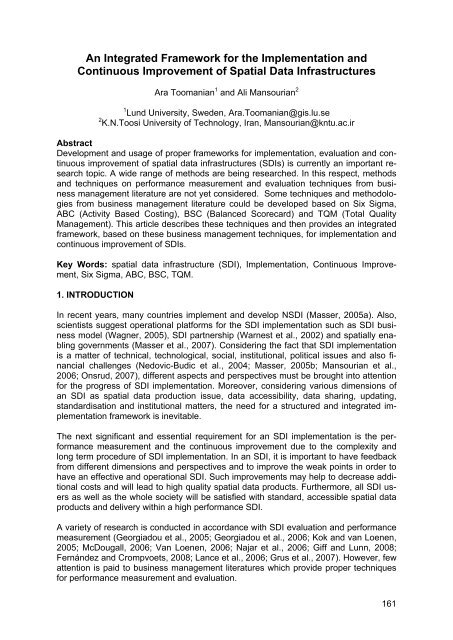SDI Convergence - Global Spatial Data Infrastructure Association
SDI Convergence - Global Spatial Data Infrastructure Association
SDI Convergence - Global Spatial Data Infrastructure Association
Create successful ePaper yourself
Turn your PDF publications into a flip-book with our unique Google optimized e-Paper software.
An Integrated Framework for the Implementation and<br />
Continuous Improvement of <strong>Spatial</strong> <strong>Data</strong> <strong>Infrastructure</strong>s<br />
Ara Toomanian 1 and Ali Mansourian 2<br />
1 Lund University, Sweden, Ara.Toomanian@gis.lu.se<br />
2 K.N.Toosi University of Technology, Iran, Mansourian@kntu.ac.ir<br />
Abstract<br />
Development and usage of proper frameworks for implementation, evaluation and continuous<br />
improvement of spatial data infrastructures (<strong>SDI</strong>s) is currently an important research<br />
topic. A wide range of methods are being researched. In this respect, methods<br />
and techniques on performance measurement and evaluation techniques from business<br />
management literature are not yet considered. Some techniques and methodologies<br />
from business management literature could be developed based on Six Sigma,<br />
ABC (Activity Based Costing), BSC (Balanced Scorecard) and TQM (Total Quality<br />
Management). This article describes these techniques and then provides an integrated<br />
framework, based on these business management techniques, for implementation and<br />
continuous improvement of <strong>SDI</strong>s.<br />
Key Words: spatial data infrastructure (<strong>SDI</strong>), Implementation, Continuous Improvement,<br />
Six Sigma, ABC, BSC, TQM.<br />
1. INTRODUCTION<br />
In recent years, many countries implement and develop N<strong>SDI</strong> (Masser, 2005a). Also,<br />
scientists suggest operational platforms for the <strong>SDI</strong> implementation such as <strong>SDI</strong> business<br />
model (Wagner, 2005), <strong>SDI</strong> partnership (Warnest et al., 2002) and spatially enabling<br />
governments (Masser et al., 2007). Considering the fact that <strong>SDI</strong> implementation<br />
is a matter of technical, technological, social, institutional, political issues and also financial<br />
challenges (Nedovic-Budic et al., 2004; Masser, 2005b; Mansourian et al.,<br />
2006; Onsrud, 2007), different aspects and perspectives must be brought into attention<br />
for the progress of <strong>SDI</strong> implementation. Moreover, considering various dimensions of<br />
an <strong>SDI</strong> as spatial data production issue, data accessibility, data sharing, updating,<br />
standardisation and institutional matters, the need for a structured and integrated implementation<br />
framework is inevitable.<br />
The next significant and essential requirement for an <strong>SDI</strong> implementation is the performance<br />
measurement and the continuous improvement due to the complexity and<br />
long term procedure of <strong>SDI</strong> implementation. In an <strong>SDI</strong>, it is important to have feedback<br />
from different dimensions and perspectives and to improve the weak points in order to<br />
have an effective and operational <strong>SDI</strong>. Such improvements may help to decrease additional<br />
costs and will lead to high quality spatial data products. Furthermore, all <strong>SDI</strong> users<br />
as well as the whole society will be satisfied with standard, accessible spatial data<br />
products and delivery within a high performance <strong>SDI</strong>.<br />
A variety of research is conducted in accordance with <strong>SDI</strong> evaluation and performance<br />
measurement (Georgiadou et al., 2005; Georgiadou et al., 2006; Kok and van Loenen,<br />
2005; McDougall, 2006; Van Loenen, 2006; Najar et al., 2006; Giff and Lunn, 2008;<br />
Fernández and Crompvoets, 2008; Lance et al., 2006; Grus et al., 2007). However, few<br />
attention is paid to business management literatures which provide proper techniques<br />
for performance measurement and evaluation.<br />
161

















